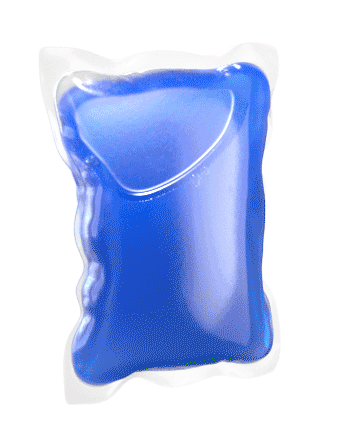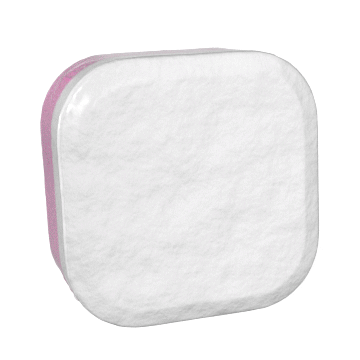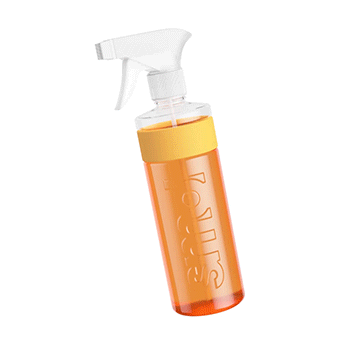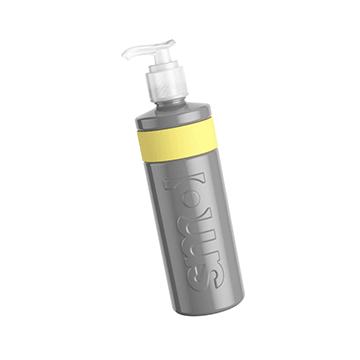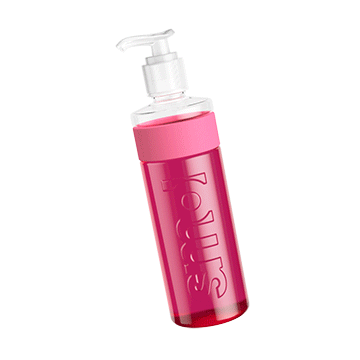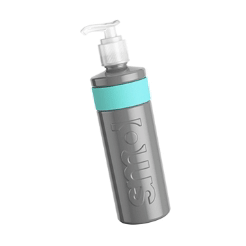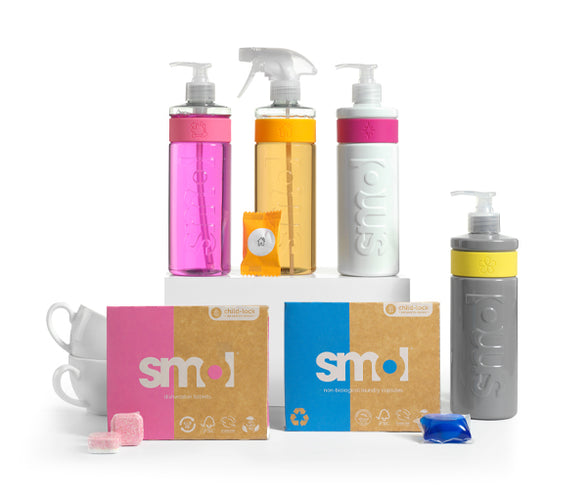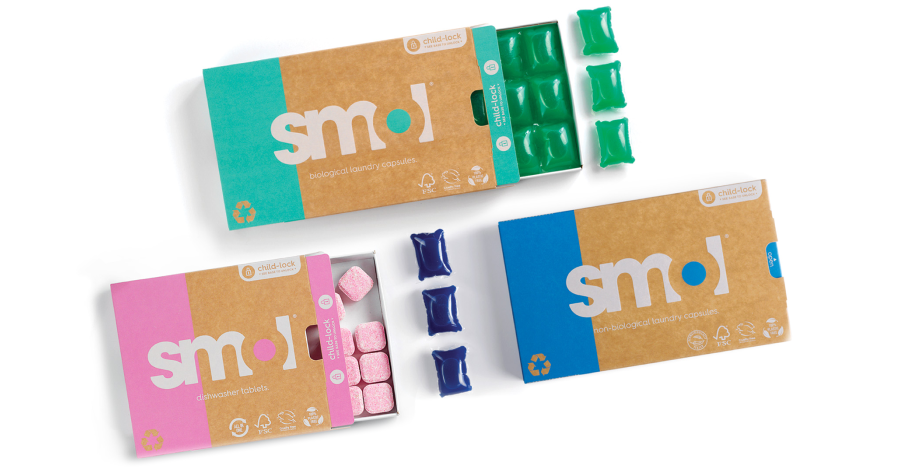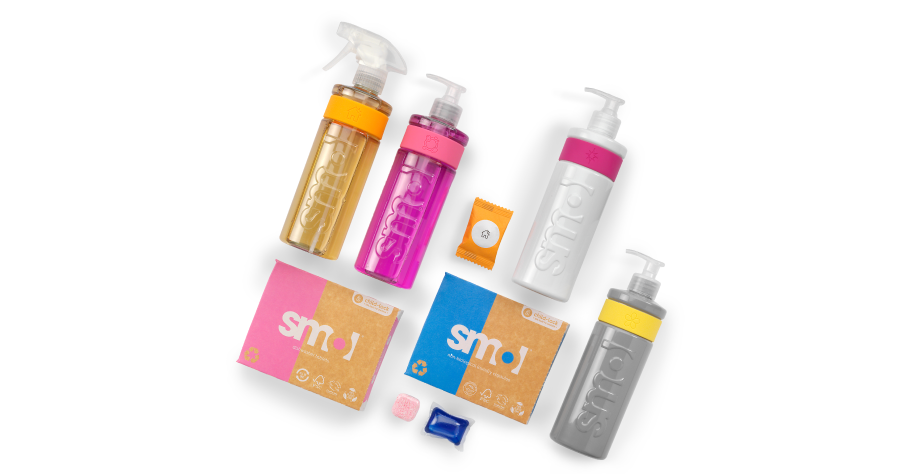
Packaging. It gets a bad (w)rap… and deservedly so. Particularly single-use plastic packaging.
Plastic packaging in the UK accounts for nearly 70% of our plastic waste, covering our food, containing our drinks, encasing the stuff we buy for our homes… it’s something all brands MUST consider when they decide how to package and protect their products.
Back in 2018, we launched our smol laundry capsules in 100% recycled plastic packs. It was a step-up from the brand new plastic that the main brands were using but even then we knew we could do better. We worked tirelessly to change this and introduced our world-first child-impeding, home-compostable cardboard laundry packs just 2 years later.
Ditching the plastic felt good.
But the cold truth remains that every type of packaging still demands resources… energy, raw materials, labour and transportation. In fact the only true eco-packaging is NO packaging. And for many products that is simply not an option.
You’ll notice for some of our products we still use 100% recycled plastic. This is what’s called Post-Consumer Resin plastic - or PCR plastic, and we’re often asked what exactly is it? How is it made? And what makes it better than virgin plastics?
So let’s take a look…
What is PCR plastic made from?
It consists of recycled plastics such as:
- PET (used in water bottles)
- PP or Polypropylene Plastic (used in lids of sauce bottles for example)
- HDPE or High-Density Polythene (used in cleaning product bottles)
It’s all just basically the plastic from your home that pours into the waste system via your kerbside collection.
How is it made?

- The plastics are sorted based on their type of material
- Then either melted, shredded or ground into pellets or fine granules
- Next the pellets are melted down and remoulded
- This creates new PCR plastic products, without any additional brand new plastic material
That’s certainly the case where smol uses PCR plastic, we always look for 100% recycled material so we know that no new plastic is being required.
What is so good about PCR plastic?
At first glance, PCR plastic is simply taking a waste product, turning it into something useful once again and keeping it OUT of landfill, OUT of the oceans or preventing it from being incinerated and releasing its carbon that way. It is taking something that has already been manufactured and extending its useful life. The additional benefits of not needing brand new fossil resources are of course important and a major attraction to us here at smol.
PCR plastic is also created using far less water and less energy than virgin plastic and generates fewer carbon emissions than manufacturing its equivalent out of brand new plastic.
One report* took a detailed look at all lifecycle impacts involved in making a product from PCR plastic compared to the same product being made from virgin plastic.
It concluded that using PCR plastic reduced energy consumption by 79% for PET, and by 88% for HDPE and PP. It also reduced all greenhouse gas emissions during production.

AND what’s really great is that it is a durable material. This is additionally important to us here at smol when selecting a material for our refillable bottles. We want these to live on indefinitely, being refilled time and time again so they need to be sturdy and long-lasting.
Refilling and reusing a plastic bottle each time means our customer saves 41.4 grams of carbon dioxide. Over the course of a year, two years, five years… you can see how the savings add up when you refill your bottle and don’t buy new.
Are there any disadvantages to PCR plastic?
Unfortunately, as a material, PCR plastic does have limitations. For example, it may not be used in the food industry as there are issues around food safety. It is not suitable to use as a packaging material for fruit or vegetables. Which is a shame because such a high percentage of plastic waste comes from the packaging we use in the food industry.
PCR plastic can also not be manufactured in any colour so that might be off-putting for some brands. It’s hard to make a proper transparent pot for example because PCR plastic is just not fully transparent. It is made from different types of waste plastic from multiple different original items which makes it hard to create a consistent uniform look.
Can PCR plastic be recycled itself?
Depending on how the PCR plastic is used it can actually be recycled again after use which makes it a circular material. Some studies show you can safely recycle PCR plastic between 7 and 9 times before the fibres have degraded to an extent that makes them unsuitable for further use.
Of course much better to refill rather than recycle but at least the recycling option is there.
So will we always use PCR plastic in our range?
Finding viable alternatives to plastic packaging is a constant and ongoing mission here at smol so we hope one day to end our use of recycled plastic. In the meantime it’s an improvement on the status-quo within the cleaning industry and the millions of brand new plastic packs spewing out from the big brands every year.
Pledges by the likes of Unilever and Procter & Gamble to cut their use of single-use plastic in 5 or 10 years and slightly increase their use of PCR plastic is pitiful. They have put profit over planet for many decades. We hope that pressure from small independents like smol and growing awareness from the population will force them finally to step up.
PCR plastic is not perfect.

To make measurable change we don’t need a handful of people doing zero waste perfectly. We need millions of people doing it imperfectly.
A huge number of our customers take advantage of our Rinse, Return and Lend a Hand scheme whereby for every 4 empty bottles sent back to us to reuse, we'll donate 1 pack of laundry capsules to The Hygiene Bank, who work tirelessly to end hygiene poverty for the most vulnerable nationwide. This means our bottles can be used again and again which of course is great news for the environment, while supporting an amazing cause.
And whilst we’re not sure any packaging is perfect, in our opinion refillable PCR improves on the billions of brand new plastic packs that are used once and thrown away.
For now, we will continue to use it with some of our smol products but as we love to say… watch this space!
